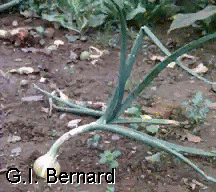
| |
 |
![]()
 Mother Earth News, Sep/Oct 1987
Mother Earth News, Sep/Oct 1987
The Easiest Seed-Saving Crops
By Nancy Bubel
Some onions do go to seed the first year, but those aren't the ones you want to reproduce. Instead, choose bulbs that have kept well in cool, dry winter storage. Replant them a few inches apart in early spring. Separate different varieties of this insect-pollinated crop by at least 100 feet. Onion seed also shatters readily, so watch closely for the black seeds to form, then collect the seed heads promptly.
The Arc Institute
Prepare the bulbs for harvest when 50% of the onion tops have fallen over. Knock the rest of the tops over too, and the bulbs will form protective skins while the tops dry up. Do not water at this point. Bulbs can be pulled then and dried on the ground unless it is wet. Store in a hanging net is a cool cellar. Plant 1/4-1/2” deep, 2-3” apart, in rows 18” apart.
Onions multiply by either sexual or asexual means. Sexual is in the same manner as other plants: they bloom and produce seed. Asexual is by division. The cells in the bulb divide and form another bulb. Asexual is not often seen in most varieties of onion since we normally harvest the bulb in the first year for our consumption. However some varieties, especially small bunching onions and shallots, multiply primarily by division and a few are always left by the grower to allow for this division. Large bulb varieties rarely divide. You could probably force them to if you kept them from going to seed and rotting away. Basically, they need lots of space to grow into, and time.
My father has a couple of varieties of shallots that he leaves in place year-round. Each year they approximately double in bulb quantity. When they get crowded they go to seed so he clips off the seed heads and thins them out (by selective harvesting) thereby leaving more space for them to continue to divide. (Division is a *slow* process and takes more than just one year.) When thinning, one should pay particular attention to poor looking bulbs that may be genetically challenged or diseased. These should definitely be thinned. Then thin whatever you want to eat!
Offered by Roger.